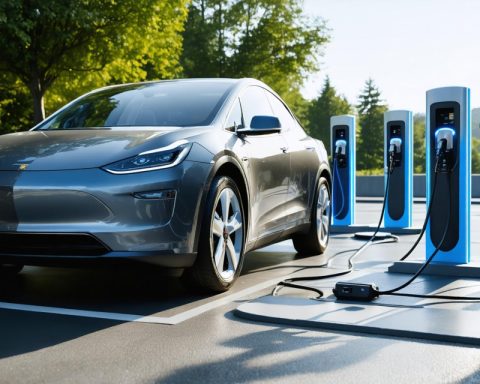- Hydrogen’s role in energy transportation is crucial, especially through X70 pipeline steel.
- Researchers use high-pressure hydrogen charging and thermal desorption analysis to study hydrogen behavior in steel.
- A refined trapping model simulates real-world scenarios of hydrogen diffusion and saturation in pipeline steel.
- The model integrates experimental evidence to depict hydrogen’s interaction with steel accurately.
- Independent experimental validation supports the model’s reliability and accuracy.
- This research enhances the understanding of hydrogen diffusion, impacting pipeline infrastructure efficiency and robustness.
- The study contributes to a future-ready energy system leveraging hydrogen as a primary vector.
In an era rapidly embracing sustainable energy, hydrogen stands out as a beacon of hope, especially in the transportation of energy through pipelines. Deep within the heart of these steel veins lies a puzzle crucial to efficiency: the behavior of hydrogen when fused with X70 pipeline steel.
Scientists have embarked on a journey to decode this mystery using a fascinating blend of high-pressure gaseous hydrogen charging and precision-focused thermal desorption analysis. They crafted a trapping model, meticulously engineered to mirror the real-world scenario. Crafted with electrochemical hydrogen charging, this model holds the key to understanding how hydrogen seeps, traps, and ultimately saturates the steel.
Picture a tapestry forming: intricate yet cohesive. The model weaves together evidence from rigorous experiments and analysis. Through cutting-edge simulation, a unified approach emerges, enabling the accurate depiction of hydrogen’s dance within the steel matrix. Independent validation from diverse experimental data bolsters the model’s credibility, showcasing its prowess in capturing hydrogen’s elusive nature.
This breakthrough doesn’t just stop at theory. The practical implications reverberate across an industry that’s steeling itself for a hydrogen-fueled future. By enhancing our grasp of hydrogen diffusion and trapping, such research propels us toward more robust and efficient pipeline infrastructures.
The essential takeaway: with precision modeling and robust validation, hydrogen diffusion in pipeline steel can be predicted with remarkable accuracy, pointing towards a more reliable and forward-thinking approach in the adoption of hydrogen as a primary energy vector. In this dance of molecules and metal, future-proofing our energy systems may well hinge on such scientific strides.
The Future of Hydrogen Pipelines: A Game Changer for Sustainable Energy
How-To Steps & Life Hacks
Understanding the transportation of hydrogen through pipelines requires both scientific and practical insights. Here are steps that help tackle key aspects of this process:
1. Identify the Pipeline Material: Choose materials like X70 pipeline steel, known for good balance between strength and ductility, essential for hydrogen transport.
2. Conduct Electrochemical Hydrogen Charging: This method implants hydrogen atoms into the steel, simulating real-world conditions.
3. Apply Thermal Desorption Analysis: This technique releases and measures the hydrogen to understand trapping behavior.
4. Develop Predictive Models: Use experimental data to craft models predicting hydrogen behavior within different steel matrices.
5. Implement Real-Time Monitoring: Sensors and real-time data collection can detect risk zones within pipelines.
Real-World Use Cases
– Pipeline Infrastructure: Hydrogen pipelines are pivotal in regions investing in hydrogen as a clean energy source. Countries in the EU green hydrogen initiative are major adopters.
– Energy Storage: Hydrogen can efficiently store excess solar or wind energy, a significant advantage for renewable energy management.
Market Forecasts & Industry Trends
The hydrogen market is set to grow exponentially:
– The global hydrogen market size is predicted to expand from USD 130 billion in 2020 to USD 300 billion by 2030, driven by applications in transportation and industry IEA.
– Green hydrogen, produced via renewable energy, is gaining investment traction as nations aim for carbon neutrality.
Reviews & Comparisons
Comparison of pipeline materials:
– X70 Steel: Known for its strength, with proven models predicting hydrogen compatibility.
– Fiberglass or Polymer Coatings: Used in conjunction with steel for additional protection but vary in cost and durability.
Controversies & Limitations
While promising, the hydrogen pipeline infrastructure faces challenges:
– Embrittlement Risk: Hydrogen can cause steel embrittlement, posing safety concerns.
– Infrastructure Cost: High initial costs for retrofitting or building pipelines.
Security & Sustainability
– Enhanced Safety Protocols: Necessary due to the high flammability of hydrogen.
– Sustainability Focus: Development of eco-friendly extraction and pipeline technologies is a priority.
Pros & Cons Overview
Pros:
– Reduced CO2 Emissions: Significant reduction when compared to fossil fuels.
– Efficiency: Hydrogen can be transported over long distances with minimal energy loss.
Cons:
– Technical Challenges: Problems like pipeline corrosion and embrittlement.
– Cost: Initial investment for infrastructure development is high.
Actionable Recommendations
Invest in Innovations: Support R&D in materials science and pipeline technology to enhance safety and efficiency.
Monitor Technology Advancements: Keep abreast of emerging technologies that address existing limitations, such as improved pipeline materials or hydrogen sensor systems.
Embrace Policy Changes: Support legislative frameworks incentivizing the adoption of hydrogen as a clean energy source.
In summary, the blending of science, technology, and policy is crucial for realizing the potential of hydrogen pipelines as the backbone of a sustainable energy future. By understanding and addressing challenges, like material compatibility and safety, we can pave the way for a hydrogen-driven world.














